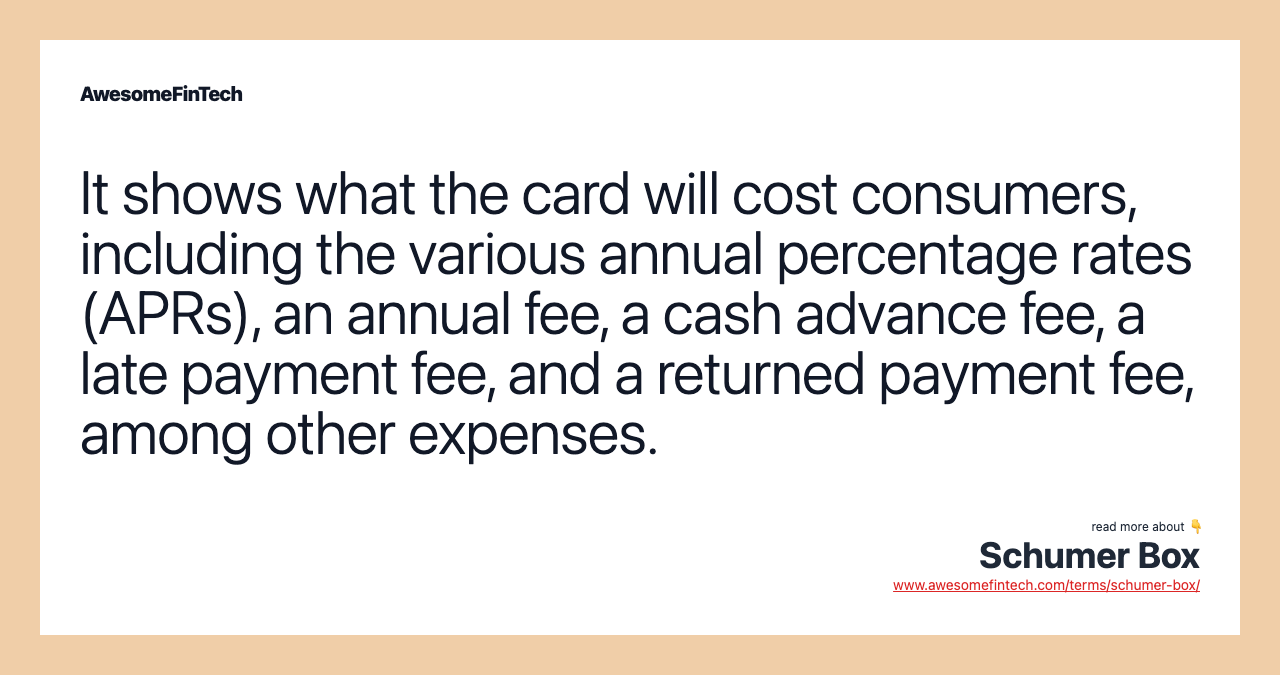Schumer Box
A Schumer box is a table that appears in credit card agreements showing basic information about the card’s rates and fees. The Schumer box shows information about the card’s cost to consumers, including its annual percentage rate (APR) for purchases, APR for balance transfers, APR for cash advances, penalty APR, grace period, annual fee, balance transfer fee, cash advance fee, late payment fee, over-limit fee and returned payment fee. It shows what the card will cost consumers, including the various annual percentage rates (APRs), an annual fee, a cash advance fee, a late payment fee, and a returned payment fee, among other expenses. Say the Schumer box for one credit card shows that the card’s APR is 8.99%, 10.99%, or 12.99% based on a potential borrower’s creditworthiness. A Schumer Box is a required summary of a credit card's rates and fees that is visible in credit card agreements.

What Is a Schumer Box?
A Schumer box is a table that appears in credit card agreements showing basic information about the card’s rates and fees. The Schumer box shows information about the card’s cost to consumers, including its annual percentage rate (APR) for purchases, APR for balance transfers, APR for cash advances, penalty APR, grace period, annual fee, balance transfer fee, cash advance fee, late payment fee, over-limit fee and returned payment fee. Credit card issuers must provide the Schumer box with all credit card solicitations, whether the offer is online or through the mail.



Understanding a Schumer Box
Schumer boxes of several different credit cards can help illustrate the similarities and differences among them. The box is named after New York Senator Charles Schumer — at the time Congressman Schumer — because he was involved in the legislation that created it. That legislation is known as the 1968 Truth in Lending Act, and its purpose was to protect consumers in transactions with lenders and creditors.
To adequately interpret the information presented in the Schumer box, it’s important to have an understanding of what a prime rate is and how it affects credit card rates. The prime rate is the interest rate that commercial banks charge their most creditworthy customers. Understanding this can help determine what APR the credit card issuer is likely to give based on an individual’s credit score.
The information presented in the Schumer box does not encompass all the criteria on which one should base a credit card decision. Other items for consideration include how a credit card company's rewards program works, how to earn a sign-up bonus or how to keep promotional zero percent APR on balance transfers. The Schumer box also won’t offer information about other cardholder benefits, like travel insurance and return protection. Information about those benefits can be found in a separate document.
How to Use the Information in the Schumer Box
Say the Schumer box for one credit card shows that the card’s APR is 8.99%, 10.99%, or 12.99% based on a potential borrower’s creditworthiness. If a potential borrower's credit score is 780, they can safely assume they’ll qualify for the 8.99% APR, based on their better-than-average credit score. On the other hand, if a potential borrower has a less desirable credit score of 660, they’ll likely be subject to one of the higher rates.
The Schumer box also tells consumers the type of method, such as the average daily balance method, that the credit card company will use to determine how much interest they owe.
Related terms:
Annual Percentage Rate (APR)
Annual Percentage Rate (APR) is the interest charged for borrowing that represents the actual yearly cost of the loan, expressed as a percentage. read more
Average Daily Balance Method
The average daily balance is a common accounting method where credit card interest charges are calculated using the total amount due on a card at the end of each day. read more
Balance Transfer Fee
A balance transfer fee is charged by a credit card issuer to transfer a balance from another creditor. Learn the pros and cons of balance transfers. read more
Credit Card Accountability, Responsibility, and Disclosure Act of 2009
The Credit Card Accountability, Responsibility, and Disclosure Act of 2009 is designed to protect card users from issuers' abusive lending practices. read more
Credit Score: , Factors, & Improving It
A credit score is a number between 300–850 that depicts a consumer's creditworthiness. The higher the score, the better a borrower looks to potential lenders. read more
Creditor
A creditor is an entity that extends credit by giving another entity permission to borrow money if it is paid back at a later date. read more
Issuer
An issuer is a legal entity that develops, registers and sells securities for the purpose of financing its operations. read more
Private Label Store Credit Card Defined
A private label credit card is a store-branded credit card that is intended for use at a specific store. It offers credit and sometimes special benefits at those stores. read more
Purchase Annual Percentage Rate (APR)
A purchase annual percentage rate (APR) is the interest charge that is added to the outstanding balance on a credit card. read more
Purchase Rate
The purchase rate is the interest rate applied to credit card purchases and only applies to unpaid balances at the end of the billing cycle. read more